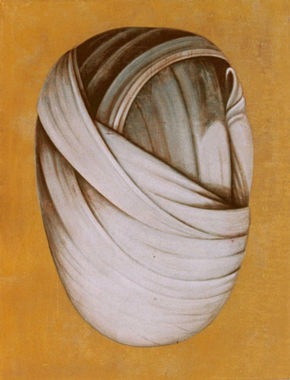Daniel García
Obras
El Autor
Trayectoria
Críticas
Contacto
Exposiciones
Disciplinas
|
Invitados
|
Eventos y Noticias
Novedades
Acerca de...
 | |
|
| The imposing painting entitled Gran vendaje de cabeza ("Large Head Bandage") by Daniel García may be discussed as a paradigmatic image, a point of departure from which to begin an investigation into the many meanings of his work. This haunting painting depicts what at first appears to be a medieval wimple. Yet, according to the title, it is, in fact, a complicated bandage for a wounded head. The bandage floats, eerily empty, against a yellow background. It appears like an icon in some ancient painting exhorting the viewer to contemplate some aspect of the passion and death of Christ or that of a saint. The more we look at it, the more of the flux or oscillation between
abstraction and palpable reality we perceive. In this painting García deals with things both seen and unseen. The image exists in a nether-world of meanings somewhere between a mundane, deadpan picture of a tightly wound piece of cloth and a highly complex metaphor. One of its strongest symbolic meanings appears to deal with intimations of pain. The object is, after all, a bandage and it is applied to the head for a reason. We do not know what that reason is, but it must be a serious one - perhaps a result of trauma from warfare, street violence, a self-inflicted wound (Van Gogh's self-mutilation quickly come to mind) or police brutality. The cloth, in addition, becomes a metaphor of sexual repression. lf we understand it as representative of the head covering of a pious woman of Northern Renaissance Europe (as painted by a master such as Dirk Bouts, Rogier van der Weyden or Hans
Memling - all artists admired by García, incidentally) this object suggests the tight, guarded nature of morality of the time. The Gran vendaje is, in addition, a quintessential still life. As in virtually all of his painting, García abstracts parts of the body or palpable articles of everyday use, monumentalizing them out of all "normal" proportion, compelling us to contemplate them in order to decipher the multivalent possibilities of their symbolic reference. These images are both timeless and temporal, referring to existential values and specific tastes of certain moments in history. Edward J. Sullivan Extractado de Fluxus Organicus, texto del catálogo de la exhibición en la Galería Ramis Barquet de New York en octubre de 2001 |
 RosariARTE es arte de Rosario |
© Copyright RosariARTE. Todos los derechos reservados. Diseño: RosariARTE Fecha de Ultima Actualización: 26-Mar-2005 Fecha de Creación: 15-Mar-2002 |